The only gluten-free pizza crust recipe you’ll ever need. Easy to make and works with basically any gluten-free flour blend. Bakes up chewy and crispy!
Hundreds of reviewers agree this recipe makes the best gluten-free pizza crust ever!
This tried-and-true recipe was originally published in 2016 and continues to be one of my #1 recipes today.
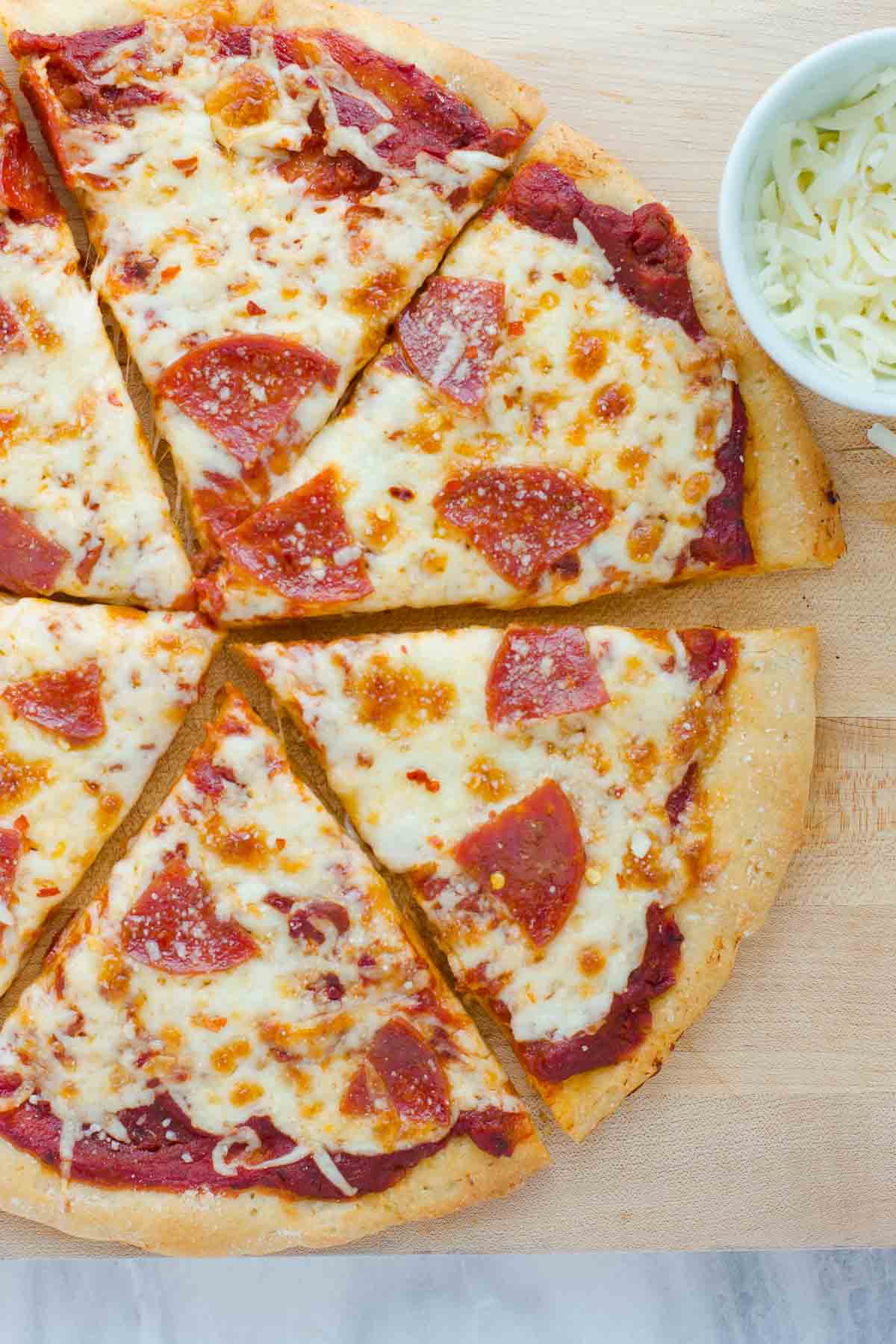
Homemade pizza night might just be my favorite food ritual! It always means happy kids, a bubbly special drink, perhaps a side of my favorite kale salad, and the best gluten-free pizza on this delicious crust.
I’ve tried a lot of gluten-free pizza crust recipes and this is my favorite. It’s easy to make and makes a crust that is both crispy and chewy.
So many gluten-free pizza crusts are thin crusts that turn out crunchy like a cracker. If you’re wanting a gluten-free crust with a good chew, this is it!
This pizza crust has the perfect amount of chew and bakes up crispy on the bottom.
You can use it as a base for any gluten-free pizza recipe. We most often use it to make classic pepperoni and BBQ chicken pizzas. You can pair it with any of your favorite toppings!
Table of Contents
Why You’ll Love this Recipe
- Easy to make
- Works well with any kind of gluten-free flour blend
- Chewy, but crispy texture
- Delicious flavor
- Work with any kind of toppings
If you’re looking for more perfected gluten-free recipes try this gluten-free banana bread, gluten-free sandwich bread, gluten-free crescent rolls or gluten-free flatbread!
Serve this pizza with these gluten-free cinnamon breadsticks!
VIDEO: Watch how to make it!
Ingredients You’ll Need
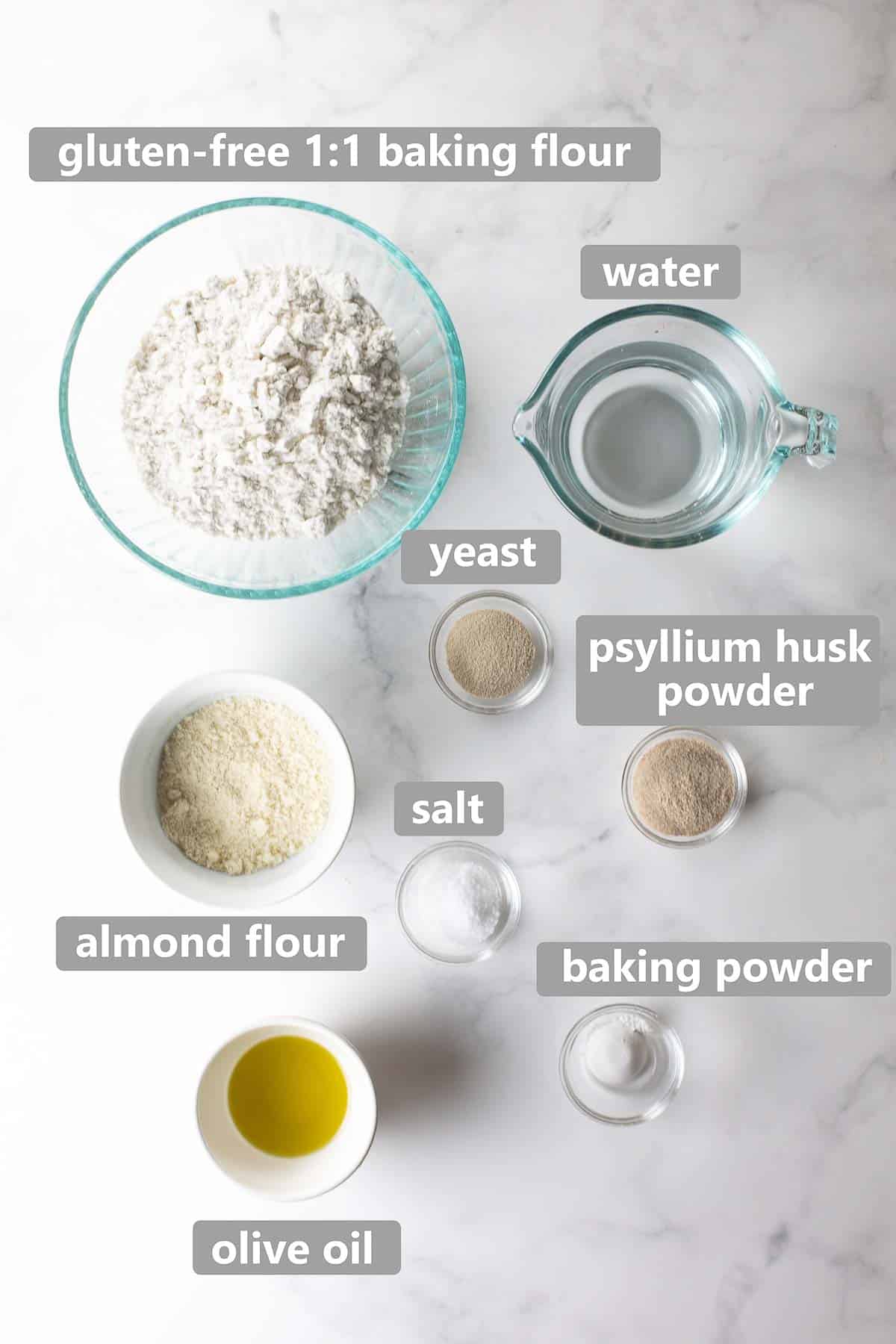
Here are a few notes on the main ingredients for this pizza crust:
- Gluten-Free 1:1 Baking Flour: I like to use a high quality gluten-free measure-for-measure flour blend like King Arthur Flour in my baked goods. This blend has a mixture of brown rice flour, white rice flour, potato starch and tapioca starch. This recipe works well with most types of gluten-free all purpose flour!
- Almond Flour: Helps with texture and browning. Adding a little almond flour is one of my favorite tricks in gluten-free baking. The extra protein/fat in the almond flour this pizza crust gives it great flavor and helps it brown up nice and golden.
- Honey or Cane Sugar: Helps activate the yeast and gives the dough great flavor.
- Psyllium Husk Powder: Don’t skip this ingredient! It had elastic properties that give the crust a springy, bready consistency.
- Baking Powder: This is an unusual ingredient in pizza crust but it lightens up the dough.
- Instant Yeast: Saf yeast is my favorite. Gluten-free doughs don’t need an extra rise, so instant yeast works great! You also might like these gluten-free cinnamon rolls.
- Salt: Gives the gluten free pizza crust great flavor!
- Olive Oil: For a little richness and golden color.
You can easily make this nut-free by leaving out the almond flour. Simply replace it with more Gluten-Free 1:1 Baking Flour!
How to Make Gluten-Free Pizza Crust
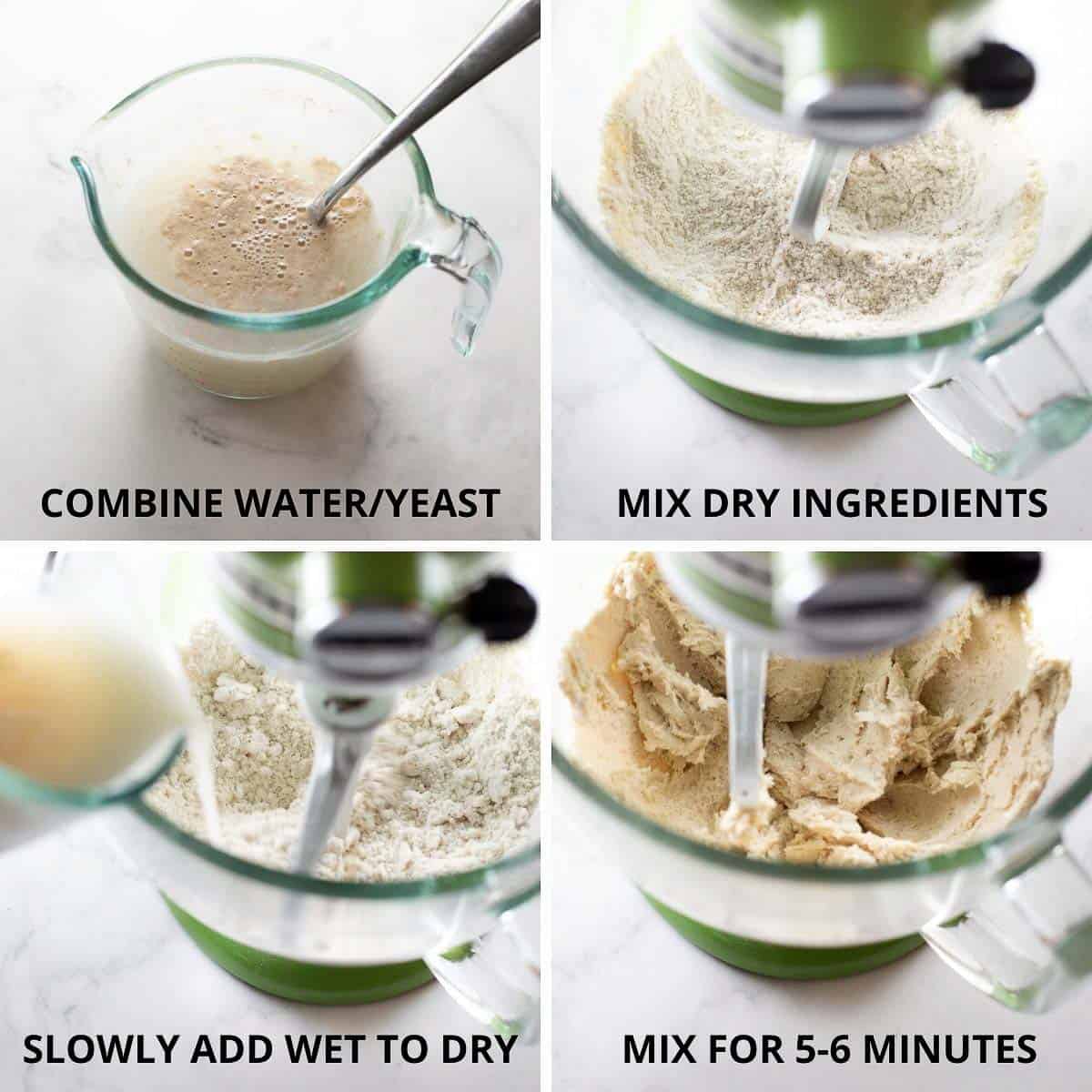
- Combine the warm water, sugar, and yeast in a glass measuring cup or small bowl. Whisk to combine.
- While the yeast is proofing for 3-4 minutes, combine the gluten-free flour, baking powder, salt, and psyllium husk powder in the bowl of a stand mixer.
- With the mixer running on low, slowly add the yeast mixture and olive oil to the dry ingredients.
- Increase the mixer to medium speed and beat for a few minutes.
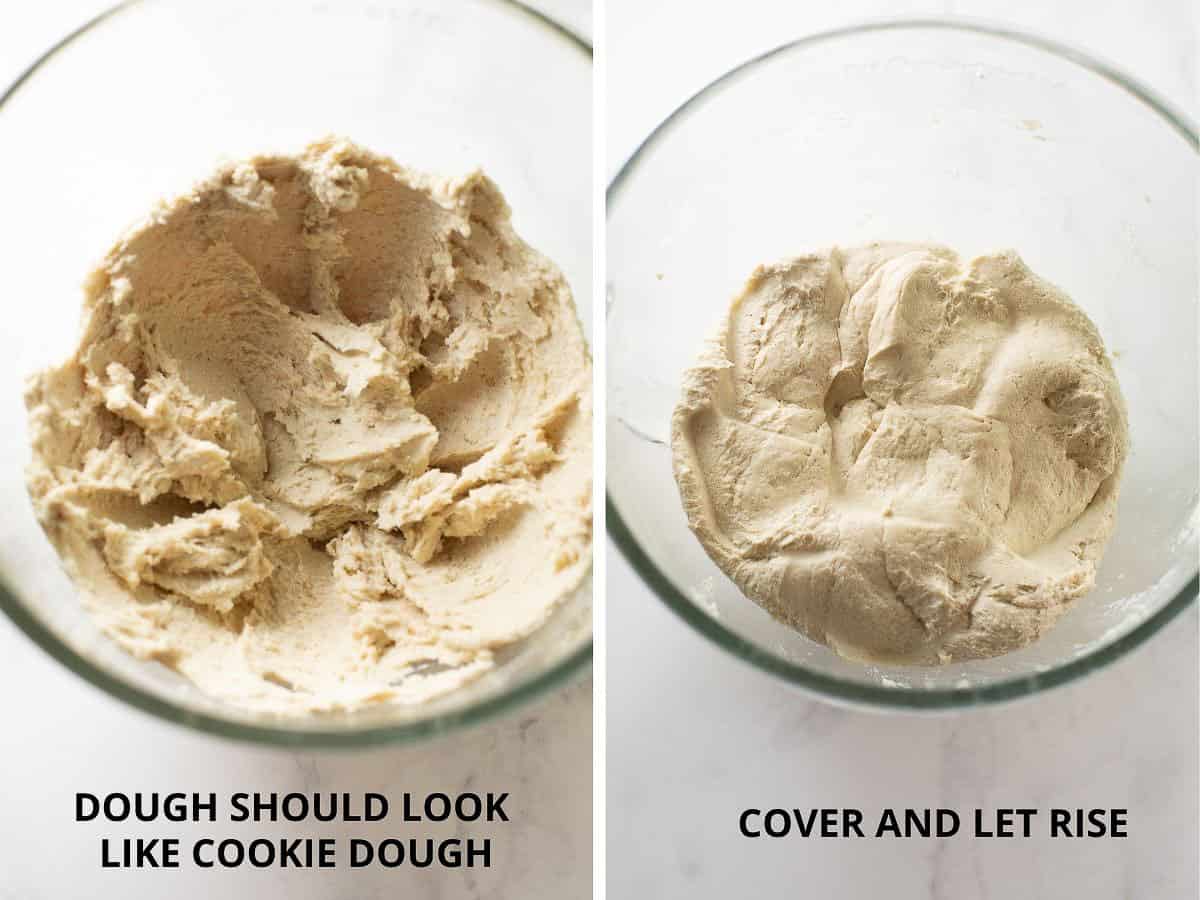
Gluten-Free Pizza Dough Consistency
Your dough might be more runny depending on what gluten-free flour blend you use. All gluten-free flour blends are slightly different and even how you measure the flour can cause differences. See the video above to get a visual on the texture you’re going for.
The dough should be more like cookie dough than runny batter. I would suggest mixing the dough for 3-4 minutes first, then adding more flour if needed (just a little at a time!) to thicken it up slightly.
- Using an oiled spatula, press the dough off the sides into a ball. Cover and let rise for 30 minutes.
- Preheat the oven to 425F. Oil a 12-inch round pizza pan. Press the dough into the pan. The best way to handle the gluten free dough is with oiled hands. The dough will shrink slightly as it bake, so press the dough as thin as you can to cover the pan. Let the dough rise for another 10 minutes at room temperature.
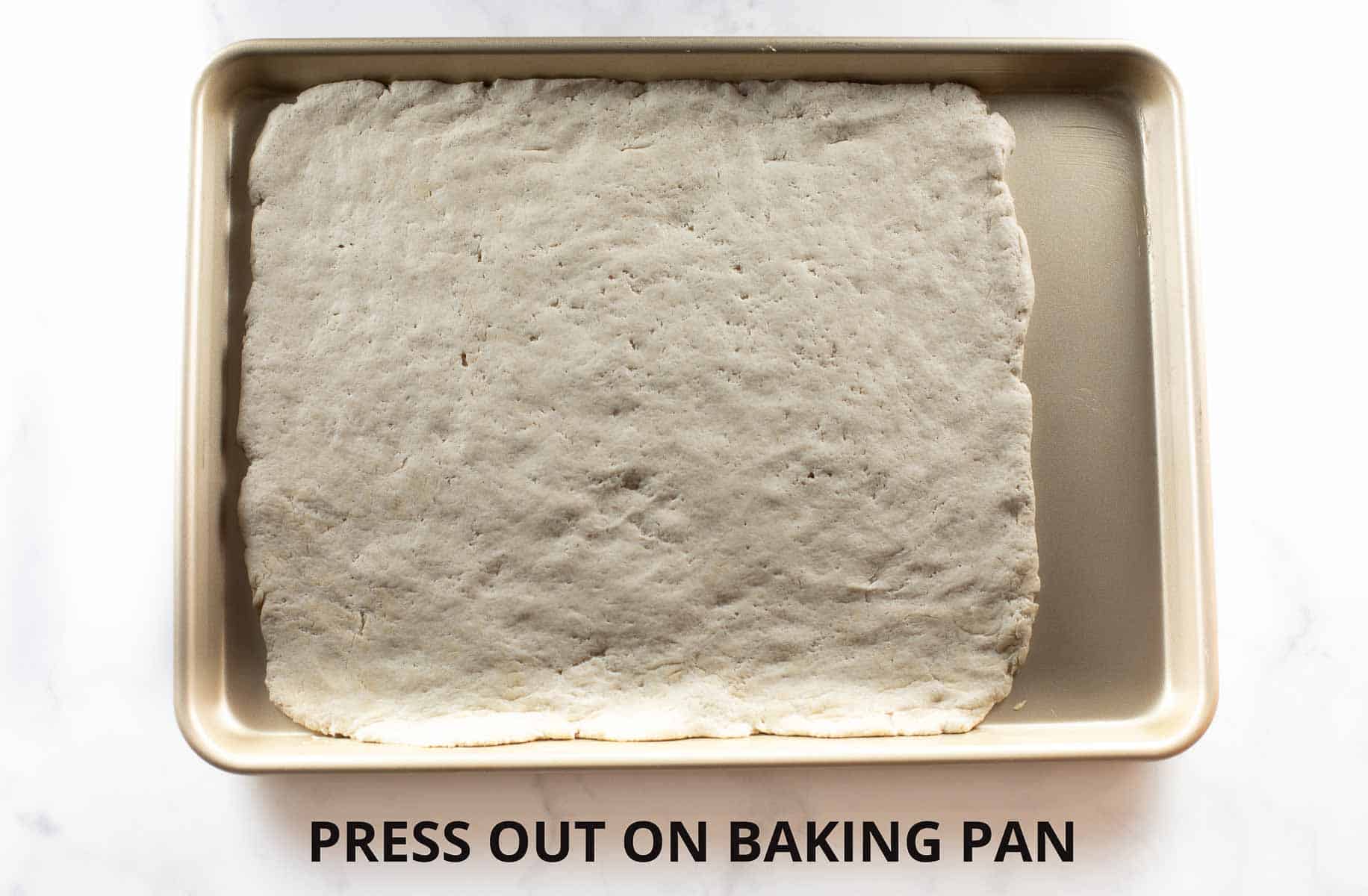
- Bake for 15-20 minutes. Remove from the oven and add your favorite sauce (tomato sauce, BBQ sauce, gluten-free alfredo sauce, etc.) and toppings. Bake for another 10-15 minutes depending on your toppings. Let cool for a few minutes before slicing. Enjoy!
Tips for the Best Gluten-Free Pizza
- One thing I’ve noticed at a lot of restaurants that serve gluten-free pizza is that the pizza never gets crispy on the bottom. Gluten-free things generally need to be baked longer than regular baked goods.
- With this recipe I parbake the crust for 15-20 minute before adding the toppings. Then bake it for another 10-15 minute with the toppings on and you’ll have perfectly crispy, chewy pizza!
- I bake the pizza on these pans, then transfer it to a wooden cutting board to slice up. Any cookie sheet will work but I recommend greasing the sheet with shortening so it doesn’t stick. You can also use parchment paper if you prefer.
- Another great thing about this crust recipe is that it works with basically any gluten-free flour blend. It turns out wonderfully with King Arthur Flour and Bob’s Red Mill gluten-free flours. You can use what you have on hand.
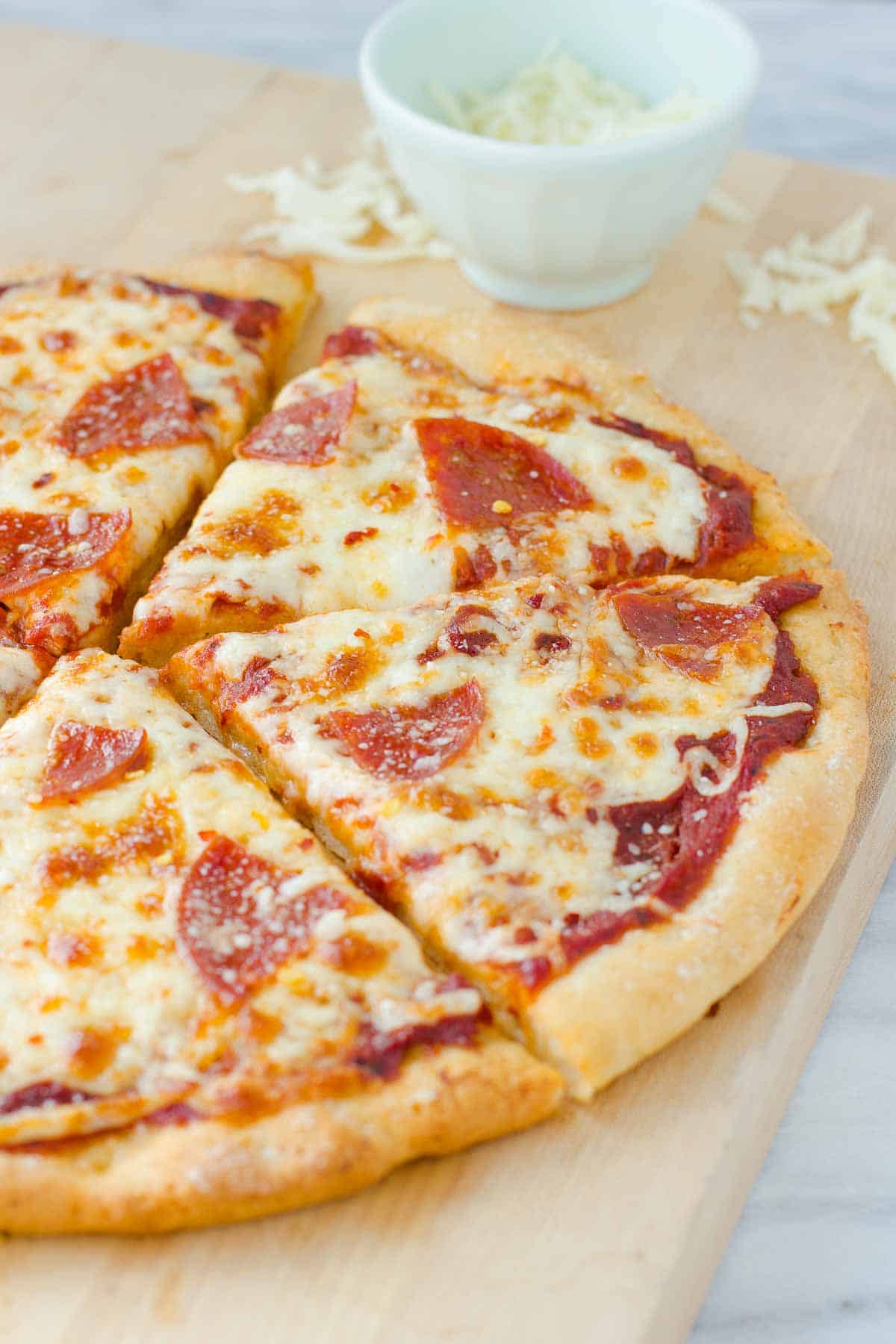
Gluten-Free Pizza FAQs
Gluten-free pizza crust is typically made from gluten-free flour, yeast, water and a binder like psyllium husk or xanthan gum. Gluten-free flour typically contains a variety of flours and starches from gluten-free grains (like rice, sorghum and tapioca flour). This gluten-free pizza crust also contains baking powder to make it lighter.
Gluten-free pizza crust is not necessarily healthier than regular pizza crust. Both regular and gluten-free pizza crust are typically made of flour and starch. It’s just the gluten-free pizza crust is made from gluten-free flours such as rice flour, tapioca starch and more.
However for those with celiac disease or gluten intolerance, making gluten-free pizza crust is a great way to enjoy pizza again.
It is best to use a high-quality gluten-free 1:1 baking flour, also known as measure-for-measure flour for gluten-free pizza dough. Gluten-free flour blends typically contain a mixture of naturally gluten-free flours and starches to mimic traditional wheat flour. Typically xanthan gum or guar gum helps is added to gluten-free flour as a binder.
Recipe FAQs
You cannot freeze the dough, but the par-baked crusts freeze great! I love making an extra crust and freezing it for later when I make this recipe. Follow all the instructions up to where you bake the crust for the first 15-20 minutes. Bake the crust for the first 15-20 minutes then cool completely.
Once cooled wrap in a layer of plastic wrap followed by a layer of foil. Freeze for up to 1 month. To bake from the freezer, preheat the oven to 425F (I like to use a pizza stone.) Top the frozen crust with toppings of choice then slide directly onto the pizza stone to bake or bake on a pan. Bake the crust for 15-20 minutes until crispy and the toppings are bubbly.
Your dough might be more runny depending on what gluten-free flour blend you use. All gluten-free flour blends are slightly different and even how you measure the flour can cause differences. See the video above to get a visual on the texture you’re going for.
The dough should be more like cookie dough than runny batter. For best results, I would suggest mixing the dough for 3-4 minutes first, then adding more flour if needed (just a little at a time!) to thicken it up slightly.
You can easily use an additional 1/4 cup gluten-free 1:1 baking flour in place of the almond flour.
Looking for more gluten-free dough recipes? Try my gluten-free breadsticks.
More Gluten-Free Recipes
I hope you love this gluten free pizza recipe as much as we do! If you try it be sure to leave me a comment/rating below. I’d love to hear from you!

The Best Gluten-Free Pizza Crust
Video
Ingredients
- 1 cup warm water about 110F
- 1 tablespoon sugar or honey
- 1 1/2 teaspoons instant yeast
- 1 1/4 cups Gluten-Free 1:1 Baking Flour (210 grams )
- 1/4 cup almond flour
- 1 teaspoon baking powder
- 3/4 teaspoon salt
- 1 tablespoon psyllium husk powder
- 2 tablespoons olive oil
Instructions
- Combine the warm water, sugar, and yeast in a glass measuring cup. Whisk to combine.
- While the yeast is proofing for 3-4 minutes, combine the flour, baking powder, salt, and psyllium husk powder in the bowl of a stand mixer.
- With the mixer running on low, slowly add the yeast mixture and oil. Increase the speed to medium-high and beat for 3-4 minutes.
- Using an oiled spatula, press the dough off the sides into a ball. Cover and let rise for 30 minutes.
- Preheat the oven to 425F. Oil a 12-inch round pizza pan. Using oiled or wet hands, press the dough into the pan. The dough will shrink slightly as it bake, so press the dough as thin as you can to cover the pan. Let rise for another 10 minutes.
- Bake for 15-20 minutes. Remove from the oven and add your desired toppings. Bake for another 10-15 minutes depending on your toppings. Let cool for a few minutes before slicing. Enjoy!
Notes
- One thing I’ve noticed at a lot of restaurants that serve gluten-free pizza is that the pizza never gets crispy on the bottom. Gluten-free things generally need to be baked longer than regular baked goods.
- With this recipe I parbake the crust for 15-20 minute before adding the toppings. Then bake it for another 10-15 minute with the toppings on and you’ll have perfectly crispy, chewy pizza!
- I bake the pizza on these pans, then transfer it to a wooden cutting board to slice up. Any cookie sheet will work but I recommend greasing the sheet with shortening (not olive oil) so it doesn’t stick. You can also use parchment paper if you prefer.
- Another great thing about this crust recipe is that it works with basically any gluten-free flour blend. It turns out wonderfully with King Arthur Flour and Bob’s Red Mill gluten-free flours. You can use what you have on hand
Nutrition
I hope you love this recipe as much as we do! If you try it be sure to leave me a comment/rating below. I’d love to hear from you!
Recipe adapted from King Arthur Flour
**This post contains affiliate links to the products I always use.
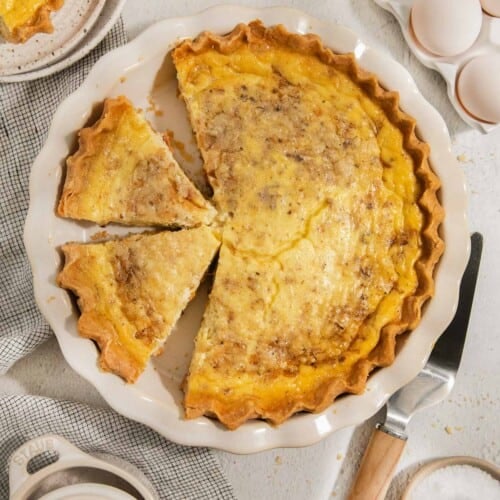

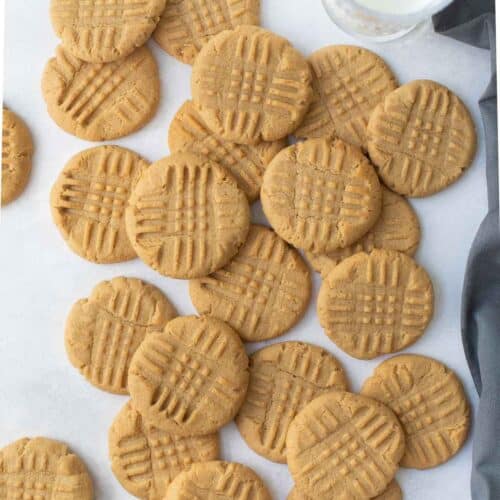
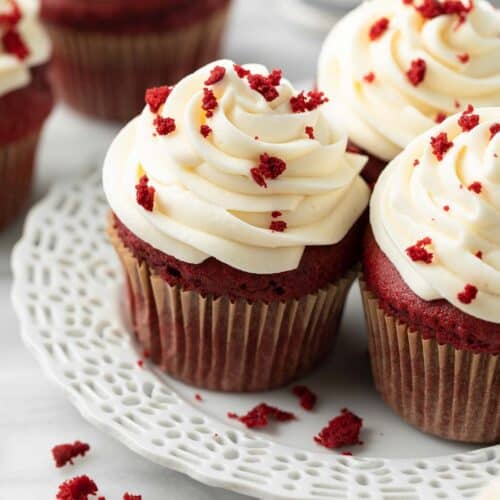
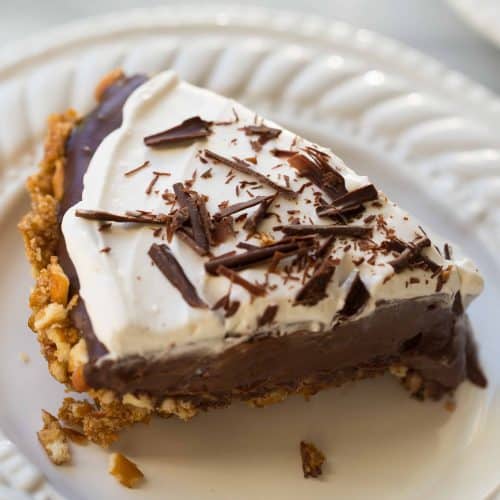
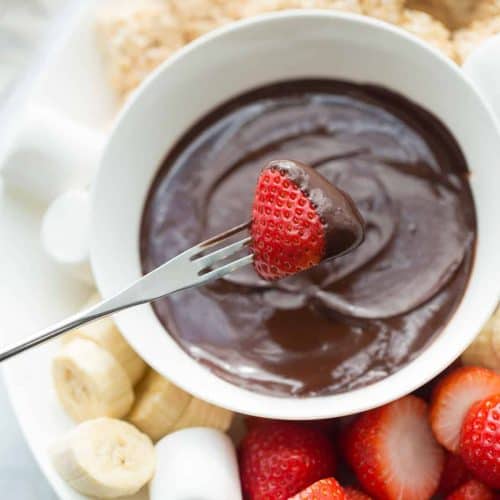

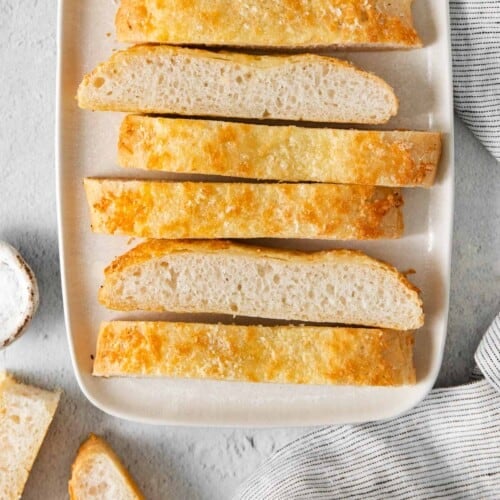

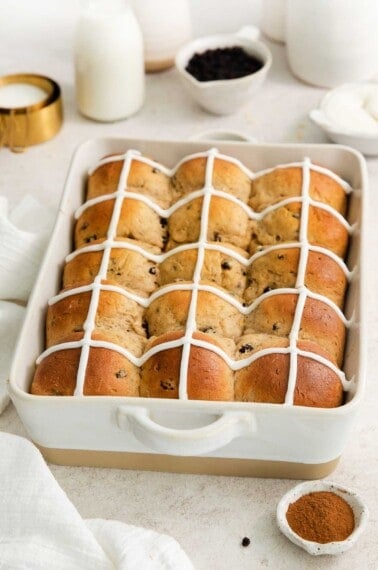
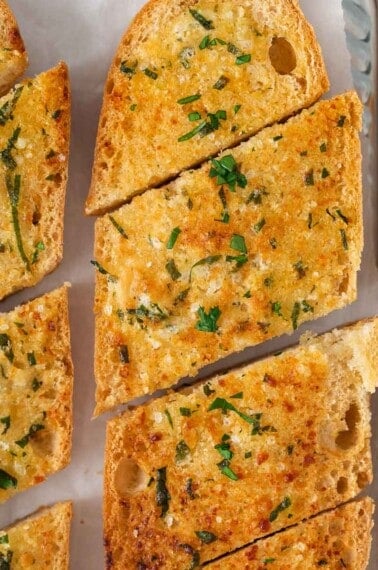
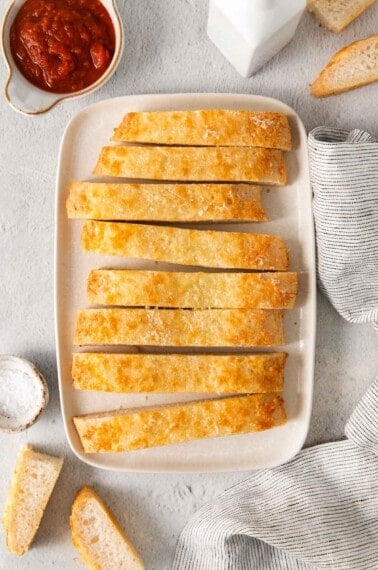
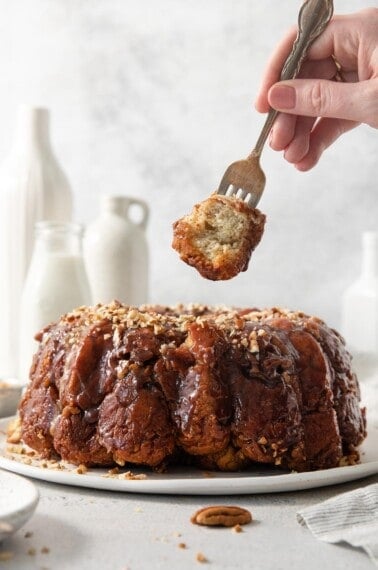










We just did a battle of the gf crusts tonight and your recipe won hands down. There aren’t even any crumbs left. So impressed with the ease of assembly, the texture both after par baking, and the end texture. No more frozen dry pizza crusts for our household anymore! Thank you
Hooray! I’m so honored my recipe won! Glad you enjoyed it 🙂
Wow, thanks so much for this recipe Erin! My son made it last night as the GF alternative along with a much more labor intensive regular pizza dough. Turned out we all preferred the GF. Nice job! Saving and sharing this one!
I’m always on the hunt for the best GF pizza crust recipe and this is now my number one! It gets a high rating for flavor, texture, as well as prep & cook time. Other recipes take way too long or just don’t have the right texture. This was just right with the crisp bottom and chewy interior. At high elevation, I only needed to par-bake for 10 minutes. Thank you so much!
Hooray! I’m so glad it turned out for you. Thanks for the comment 🙂
Pizza crust? Omgosh I cannot wait to try!
Not sure if I did something wrong. I even cooked it less time then reccomended but it didn’t have a stretchy pizza crust texture at all. Crunchy like toast. I buy a local GF crust that is amazing so maybe just used to that…
Thanks for this awesome recipe. Two questions, 1) I usually use whole wheat grain flour but do want my pizza crust to be fluffier so was thinking about including husk in it. Do you have any ideas on how much I should use per cup of flour? I worry because I’ve had the experience of too much husk and then it turning out gummy. 2) sometimes I mix the wheat with cauliflower to make the crust. Would you have ideas there on how much husk to use? I could also have just been putting way too much husk before, but seems like 1 cup of flour to 1 tablespoon is standard but wanted to check because I know gluten free flour soak up more water than whole wheat. Thanks!
My 7 year old granddaughter has coeliac disease and l have tried numerous gf pizza base recipes for her with no luck .
She absolutely loves this one, we double the recipe every time so she always has one in the freezer.
Her little brothers also love it.
Thank you for a wonderful recipe
. Ps l use 1 1/2 cups flour instead of 1 1/4 for the perfect consistency.
I’m so glad you like the recipe! Great idea to double/freeze it 🙂
I made this for a guest who is gluten free. We all tried it to compare to the neapolitan crust the rest of us were having and it was an exceptionally good crust! You wouldn’t think it was gluten free. I was a a little worried because it didn’t raise much if at all, but the consistency was really nice anyway.
I par-baked it for 15 mins earlier in the day, then for dinner we put it on the pizza stone on the grill. For the grill, it probably didn’t need to be par-baked that long since it was pretty well cooked thru in the oven. Next time I will only par-bake for 10 mins if grilling. Our pizza grill temp was between 750-850 degrees during the cooking.
I’m so glad you and your guest enjoyed the pizza! This is super helpful to know about grilling the crust. I appreciate the comment because it will help others! 🙂
I just came across your recipe and I’m very excited to try this. My only question is: have you ever baked your pizza on a pizza stone? I love the results with regular dough but would like to know if it would work with your recipe.
Thanx!
Yes! I recommend par-baking the crust on a pan at 400F first (for 20 minutes), then you can bake it with the toppings on a pizza stone. I hope this helps!
I absolutely love this recipe. Have made it twice now. The only issue I’ve found is that the recipe is far too wet & I need to add at least 1/3 more flour. The fittest time I weighed the flour & it was far too wet. The 2nd time I measured & it was almost soup. It still turned out great. Will keep trying until I figure it out what’s happening, but it still works nonetheless!
Hey Jessica! Thanks for the comment! What kind of gluten-free flour did you use? You can have very different results based on the brand of flour. The humidity can also affect this. I would just keep adding a little flour until the dough resembles cookie dough. I’m glad it still turned out great for you though!
I have been gluten free for 6 years, and finally found a pizza crust I will enthusiastically make again. This came out so good. I used instant yeast and whole psyllium husk because that’s what I had. With Bobs Red Mill 1-1 baking blend, the batter seemed too liquid at 1 1/4 cups. I added about 3 tbsp more after beating 3 minutes to get the right cookie-dough like consistency. So yummy and ready! Looking forward to the leftovers today for lunch.
I’ve never made GF pizza crust before and was very happy with this recipe. Thank you! I put a piece of plastic wrap over the dough to flatten it out with my hands – so much easier than trying to used a greased spatula. I also flattened the dough out on a piece of greased parchment paper and had no issues with it sticking to the pan or paper.
I have made this recipe twice now and my husband loved it. He asked me to make it again tonight so we didn’t have to go out and get one. Great recipe. Thank you
I’m so glad you and your husband enjoyed it! Thanks for the comment 🙂
This really is the best gluten free pizza crust. I’ve tried several other recipes with really poor results and am so happy to have found this recipe. I made it, as directed, with Bobs Redmill 1:1 gf flour, Bob’s almond flour, and psyllium husk (not powder) and it turned out great. Planning to make a double batch this week. The dough is sticky, so oil your hands generously before pressing into the pan. Thank you for such a great recipe!
Can you use whole psyllium husk rather than powder? Or can I just use a food processor to make powder? I’m new to GF with a recent wheat allergy. ) : Thanks
If you only have whole psyllium husk you can use 2 tablespoons instead of 1 tablespoon of psyllium husk powder. It will work great!